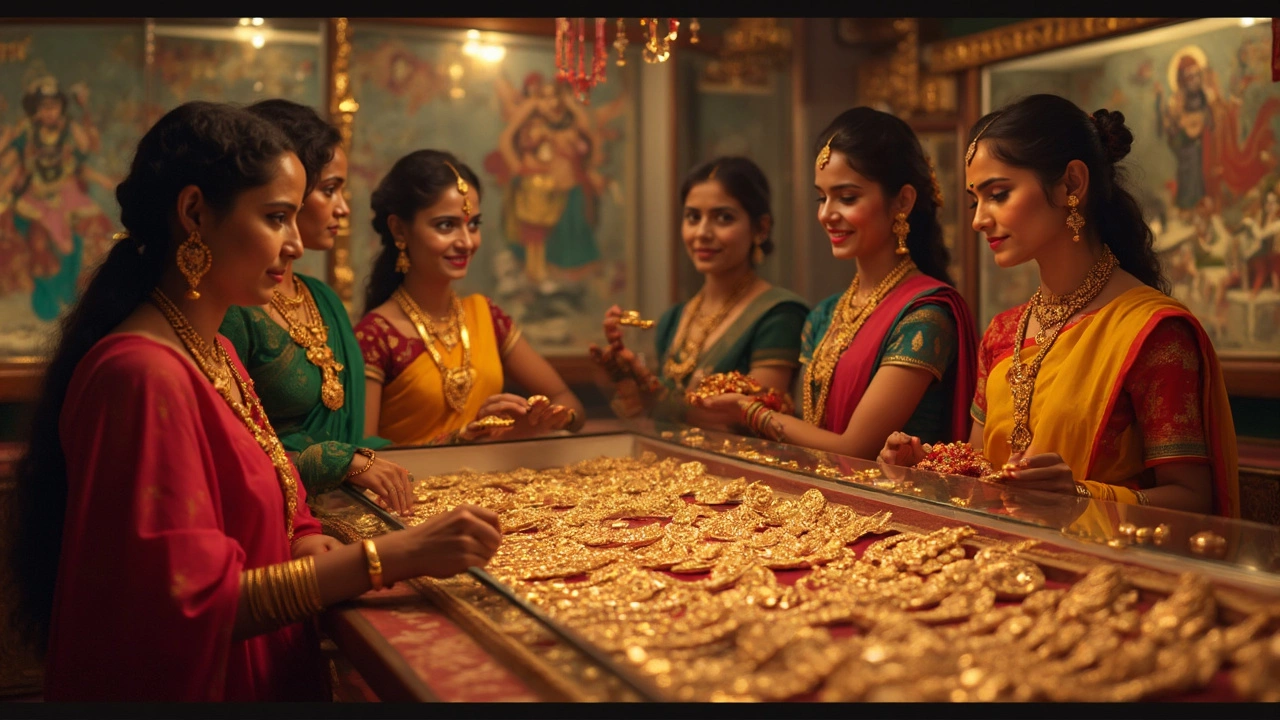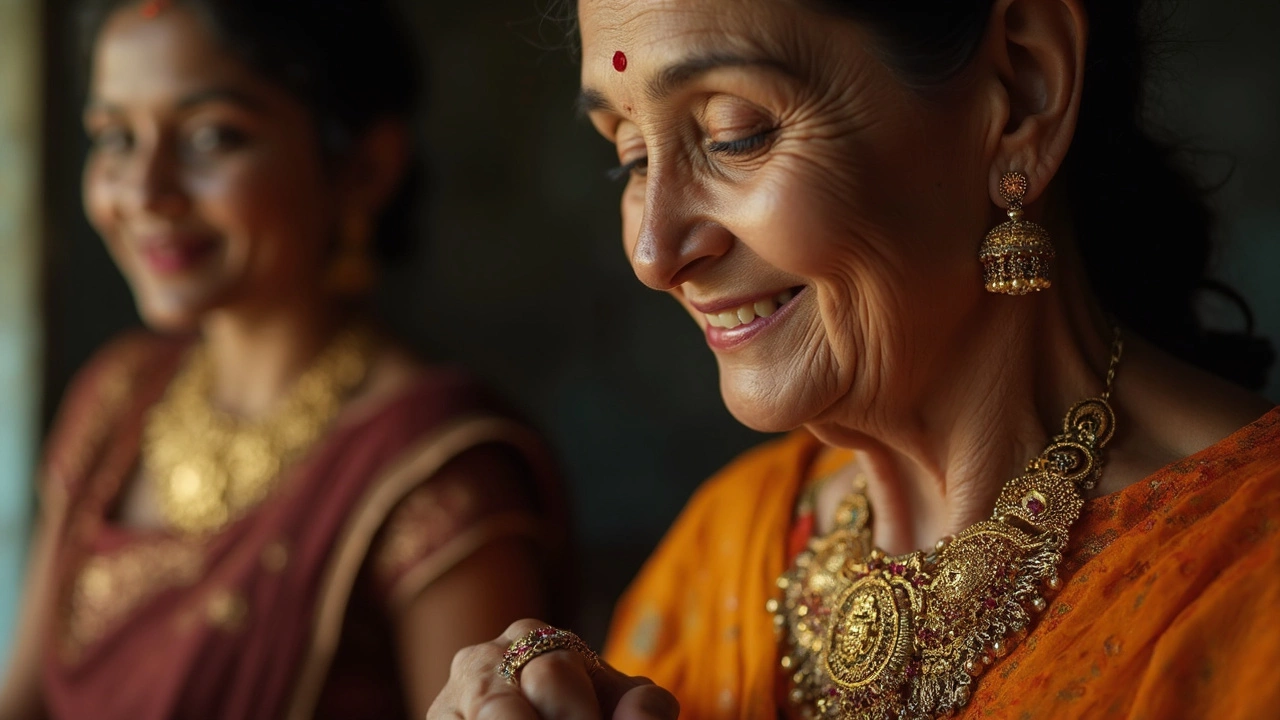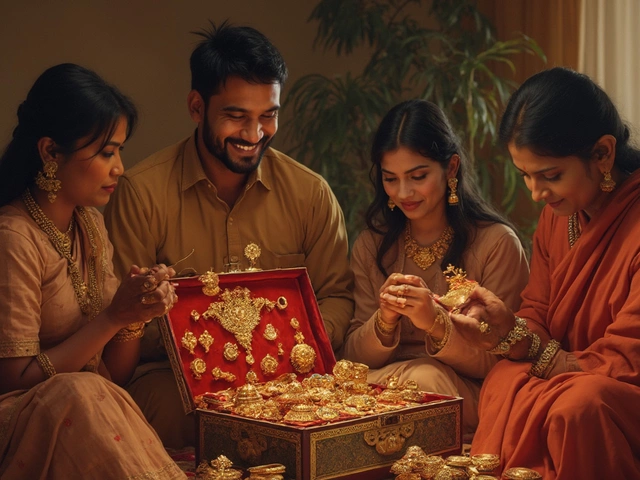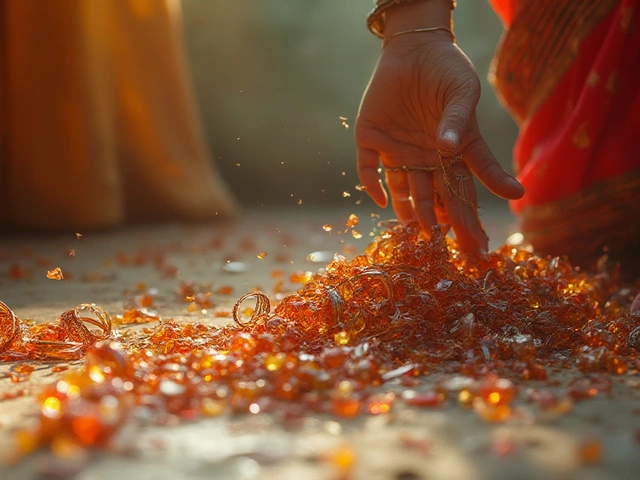
Ever noticed how Indian jewelry isn’t just shiny stuff for parties? Each piece has its own name, story, and a spot in history. Whether you’re skimming through wedding photos or browsing in a market, you’ll run into terms like 'kundan,' 'polki,' or 'temple jewelry.' It’s not just random labeling—every style actually means something and connects to a specific region or tradition.
But the phrase that pops up the most when talking old-world glam in India? Temple jewelry. These aren’t just regular earrings or necklaces—they trace back to centuries ago when dancers in South Indian temples wore them during performances. And the cool part? A lot of families still pass these pieces down like treasure; it's more about keeping stories and tradition alive than just looking fancy.
Wondering how to spot the real deal versus a mass-produced lookalike? There's a trick or two, and even if you’re not an expert, a couple of easy tips can help you pick something authentic—without breaking the bank or falling for cheap copies. Stick around and you’ll learn how to tell your temple jewelry from everyday bling, and why some pieces cost more than a smartphone.
- Names and Types of Traditional Indian Jewelry
- The Origins and Significance of Temple Jewelry
- Identifying Authentic Pieces and Materials
- Care, Styling, and Modern Trends
Names and Types of Traditional Indian Jewelry
Walk into any Indian jewelry shop and you’ll get hit with a bunch of names. It's way more than just 'necklace' and 'earrings.' Every region, every community, seems to add its own spin. Here’s a quick rundown of what to look out for if you want to sound like you know your stuff.
- Temple jewelry: This type originally comes from Tamil Nadu and Kerala. Big necklaces, chunky earrings, and unique hair accessories—all with designs picked straight from the old temples, usually featuring gods, goddesses, and peacocks. Dancers in Bharatanatyam and Kuchipudi still wear them on stage today.
- Kundan: Seen mostly in the north, especially Rajasthan. Kundan jewelry stands out because of its gold foil setting and colorful stones. It’s a top pick for weddings and serious occasions.
- Polki: This one also comes from Rajasthan and looks similar to Kundan, but uses uncut, natural diamonds. If you want bling with some old-school vibe, Polki is the way to go.
- Jadau: A technique from Gujarat and Rajasthan, where uncut stones and pearls are set in gold without lots of soldering. You'll spot these in Bollywood movies during royal scenes.
- Meenakari: Known for its pops of color, thanks to detailed enamel work. The backs of Kundan pieces often surprise you with meenakari—a sort of secret beauty.
There are also daily wear types: nath (nose ring), balis (hoop earrings), bajuband (armlet), and maang tikka (forehead dangler). If you ever go to an Indian wedding, chances are you’ll see most of these on the bride.
Gold has always been king, but silver holds a special place in rural areas and tribal communities, especially for bangles or anklets. A legit stat: gold jewelry makes up almost 80% of the Indian jewelry market, according to a 2023 report by CARE Ratings.
| Jewelry Type | Origin Region | Main Feature |
|---|---|---|
| Temple Jewelry | Tamil Nadu, Kerala | Religious motifs, chunky gold |
| Kundan | Rajasthan | Gold foil, glass stones |
| Polki | Rajasthan | Uncut diamonds |
| Meenakari | Jaipur | Enamel coloring |
| Jadau | Gujarat, Rajasthan | Hand-set stones |
As jewelry historian Usha Balakrishnan says,
“The language of Indian jewelry isn’t just about gold and stones; each piece is a chapter from our social and spiritual history.”
This is why, if you’re picking up a piece or window-shopping in India, it makes sense to look beyond just the shine—and know what kind of story or tradition you’re wearing.
The Origins and Significance of Temple Jewelry
Temple jewelry isn’t just something you spot at weddings or festivals—it started way back, over 900 years ago, right in the heart of South India. Craftsmen in places like Tamil Nadu and Kerala handcrafted these unique pieces for gods and goddesses in the big temples. At first, only deities got to wear this temple jewellery india, but soon, dancers who performed in the temples started wearing them too. It became part of classical dance styles like Bharatanatyam and Kuchipudi, so the jewelry itself almost feels like a character in those dances.
What sets traditional Indian jewelry apart, especially temple jewelry, is the design. Most pieces are shaped like lotuses, peacocks, swans, or even little sculptures of gods. Gold was always the main material, often decorated with rubies, emeralds, or tiny pearls. You’ll spot chokers, long layered necklaces, chunky earrings, and even waist belts. Even today, these designs barely change because everyone loves the old-school look.
It’s not just about dressing up, though. Temple jewelry comes loaded with meaning. In lots of South Indian families, it’s a symbol of good luck and blessings. Brides wear it for big rituals, believing it brings in good vibes for marriage. Dancers use it for authenticity—try doing a classical performance without temple jewelry and the whole costume feels off.
A cool thing is that making real temple jewelry is still a family gig for many artisans. Places like Nagercoil or Kumbakonam have goldsmiths who handcraft each piece the same way their great-grandparents did. These families use traditional tools, so you know you’re getting something real and not just a factory-made copy.
- Temple jewellery india is typically made using a technique called ‘repoussé’—hammering from the reverse side to create detailed designs.
- The jewelry was originally stored in temple treasuries and only taken out for rituals and festivals.
- Still today, classical dancers usually rent or buy full temple jewelry sets for major stage performances.
Here’s a quick snapshot of where temple jewelry shows up in daily Indian life:
| Occasion | Typical Jewelry Pieces | Why It Matters |
|---|---|---|
| Weddings | Chokers, armlets, long necklaces | Blessings and family heritage |
| Classical Dance | Headpieces, earrings, waist belts | Authenticity and tradition |
| Religious Festivals | All pieces, often on deities | Cultural and spiritual value |
The short version? Temple jewelry is more than just bling. It’s loaded with meaning, locked into tradition, and shows up wherever Indian culture celebrates heritage in style. That’s why you’ll see it in movies, on brides, or even on a dancer’s Instagram—it’s never gone out of style.

Identifying Authentic Pieces and Materials
Knowing what sets real traditional Indian jewelry apart from cheap knockoffs can save you from a bad buy. Original temple jewelry, for example, is way more than basic gold plating. Most authentic pieces use 22-karat gold—anything less is probably modern or imitation. And it’s not just about gold. Genuine pieces get their sparkle from natural stones like rubies, emeralds, uncut diamonds (called polki), and pearls. Synthetic stones are common in fakes and mass-produced styles sold online.
Here are some signs you’re looking at the real thing:
- Look for weight: Real Indian gold jewelry feels heavier than regular accessories of the same size. That’s because of the solid gold and real stones. If it feels light, be suspicious.
- Check hallmarks: Authentic pieces usually have a BIS (Bureau of Indian Standards) hallmark. This mark is small, often found in an inconspicuous spot.
- Stone setting: In genuine temple jewellery India, gems are hand-set, not glued in. The back of the piece should show little ‘cups’ or bezels holding the stones—not blobs of glue.
- Finish and detail: Real heritage jewelry is almost always hand-finished, so the detailing looks sharp and bold. Machine-made copies might have soft or uneven lines.
If you get the chance, ask for paperwork or a certificate—especially with higher-priced items. Some sellers might try to pass off gold-plated brass as the real thing. Don't be fooled by just the shine.
Here’s a quick breakdown comparing real and fake traditional Indian jewelry:
| Feature | Authentic | Imitation |
|---|---|---|
| Gold Content | 22-karat gold | Gold-plated or mixed alloy |
| Stone Type | Natural gemstones | Glass or plastic |
| Weight | Heavier | Lighter |
| Hallmark | BIS stamp | Often missing |
| Finish | Handcrafted, crisp detail | Machine-made, less detail |
Avoid impulse buys from street stalls or websites without a reputation. If you want something special, visit a trusted jeweler or check if the store sells certified temple jewellery India. Picking the real stuff means you get to keep (and maybe hand down) a piece of culture, not just another pretty accessory.
Care, Styling, and Modern Trends
If you have a piece of traditional Indian jewelry or plan on getting one, you’ll want to keep it looking sharp for years. Here’s the thing: real temple jewellery India is often made from gold, silver, or with precious stones—so sweat, perfumes, or even tap water can mess with them. Tossing these treasures in a random drawer is a quick way to get scratches or tangles you’ll regret.
- Store each piece separately in soft pouches or a lined jewelry box to avoid scratches.
- Keep your Indian gold jewelry away from direct sunlight and strong chemicals—think perfumes, sprays, or even some lotions.
- After wearing, give jewelry a quick wipe with a soft cloth to get rid of sweat or oils.
- If you’re dealing with old family pieces or ones with stones, check for loose settings now and then.
- Taking your jewelry to a pro for cleaning once a year can make a big difference, especially for intricate temple jewelry.
When it comes to styling, old meets new all the time. Women don’t just save heritage jewelry for weddings. These days, people pair heavy temple necklaces with simple tops and even jeans. Layered looks, mixing chunky gold with delicate chains, or just slipping on a pair of classic jhumkas (bell-shaped earrings) gives a pop without looking out of place. If you’re aiming for a less-is-more vibe, pick just one standout piece—maybe a nose ring or a bold bangle.
Now, if you think it’s all about grandma’s closet, check out modern Indian designers. Big names like Sabyasachi and Amrapali have their models mixing cultural jewelry with everything—Western wear, business looks, even street fashion. In fact, at a Mumbai fashion event last year, over 40% of models wore temple jewelry with blazers and sneakers. Turns out, these traditional styles easily flex into today’s trends.
| Modern Temple Jewelry Trends (2025) | Popularity (%) |
|---|---|
| Layered necklaces | 45 |
| Chunky jhumkas with casuals | 34 |
| Statement pieces with Western outfits | 52 |
| Minimalistic gold bangles | 41 |
Whether you’re buying your first piece or raiding mom’s collection, care and creativity go hand in hand. Traditional Indian jewelry can be part of your daily style, not just for rare occasions. And with styles shifting so fast, there’s a lot of fun in mixing old-school with what’s trending right now.


